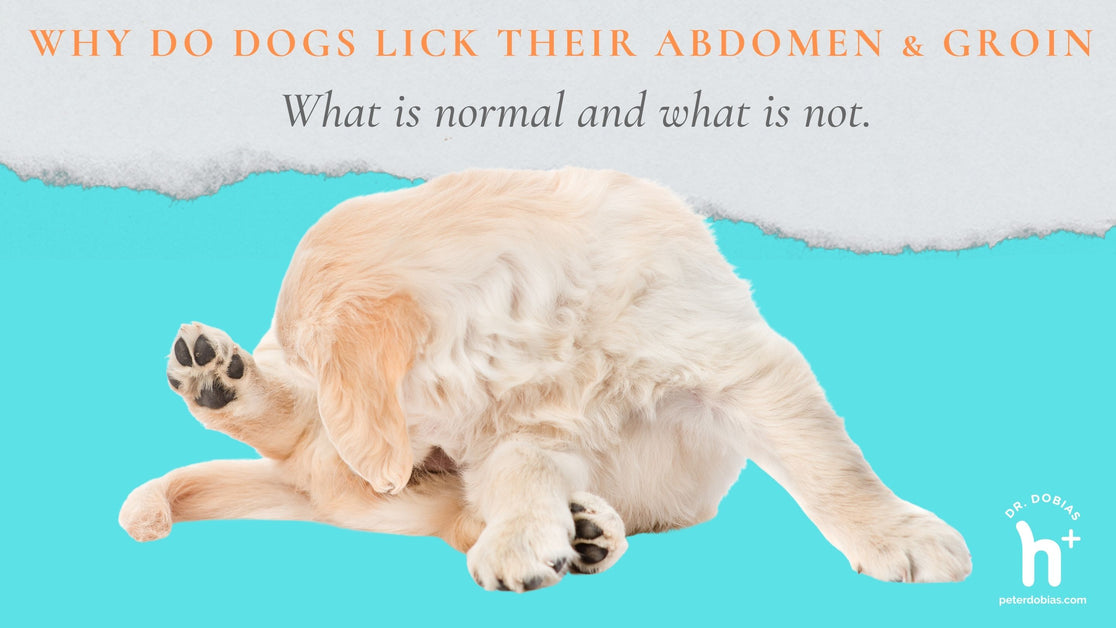

Identifying the root cause for effective relief and care
Contents
Article Summary:
This article covers common reasons why dogs lick their groin, such as muscle injuries, spinal issues, urinary problems, and skin allergies. We offer effective, drug-free recommendations for managing groin licking by addressing the primary cause and treating skin irritation, infection and inflammation. Making dietary adjustments, giving supplements, and identifying the root cause is essential for providing effective relief and ensuring your dog’s well-being.
Index:
- Introduction
-
Common Reasons Dogs Lick Their Groin
2.1 Muscle Sprain or Injury
2.2 Lumbar or Sacral Spinal Injury or Misalignment
2.3 Urinary Bladder Issues
2.4 Hernias and Genital Concerns
2.5 Other Possible Causes - Managing Skin Irritation and Inflammation from Licking
- Summary of Recommendations
1. Introduction
If your dog or puppy keeps licking their abdomen or groin area, it is natural to worry and wonder why. From my experience in practice, most people naturally jump to the conclusion that their pet has skin problems, an infection, allergies, or was bitten. While these are all possibilities, your dog’s persistent licking could be their way of signalling pain and discomfort in the area due to injury, inflammation, or possibly even bladder issues — which is actually the most common cause.
To avoid going on a wild goose chase trying to solve your dog’s problem, it’s crucial to identify the cause and seek appropriate remedies.
In this article, I delve into the most common reasons for groin licking in dogs and cats, recommend supplements to aid their recovery, and share tips on how to manage skin irritation, inflammation, and provide links to other articles on skin allergies and hotspots.
2. Common Reasons Dogs Lick Their Groin
2.1 Muscle Sprain or Injury
Dogs are active animals, and muscle injuries, including groin muscles, such as the adductor (responsible for moving the leg in), and illio-psoas muscles. These muscles may be sprained and inflamed due to injury, or from excessive one-sided exercise such as ball chasing, jumping up, or or any repetitive exercise that is out of balance.
To detect such injuries, you can touch and feel the deeper tissue in the groin and inner thighs. Your dog may yelp, flinch, or react strongly if sore.
Recommended first aid:
- If your dog seems to be in pain, is sensitive to touch, or limping, do your best to avoid non-steroidal anti-inflammatory drugs (NSAIDs) as they can cause an array of problems from gastrointestinal bleeding to liver and kidney damage.
- Rest your dog for at least 3 days or longer if necessary, and give your dog a triple the regular dose of FeelGood Omega3, rich in EPA and DHA, the essential fatty acids with powerful anti-inflammatory effect.
- Administer homeopathic Arnica 30C or 200C three times daily for 3 days. If you have a higher potency such as 1M, give two doses per day for 3 days.
2.2 Lumbar or Sacral Spinal Injury or Misalignment
Lumbar region back and spinal injuries or misalignment can lead to nerve impingement and abnormal skin sensations in the groin.
Such injuries are often caused by excessive or repetitive injuries.
Solution:
Follow the steps above and consult a professional with expertise in spinal adjustments, physical therapy or acupuncture.
2.3 Urinary Bladder Issues
Urinary tract infections, bladder inflammation, stones, or a rare form of cancer may cause a dog to lick their groin.
Solution:
If the issue is not resolved after addressing the above-mentioned steps, have your dog’s urine and blood work tested and consider an ultrasound examination if urinary stones are suspected. Skin Sensation, Itching, and Allergies
Allergies are often over diagnosed while muscular skeletal issues are overlooked. If you apply the recommendations from above and the problem doesn’t resolve, you may need to refer to my article on allergies.
2.4 Hernias and Genital Concerns
Hernias may also cause your dog to pay attention to their groin area. Check for any hernia bulges and consult your veterinarian.
2.5 Other possible causes
Other causes of abdominal licking may be insects, fleas, mosquitoes, sharp grass irritation, or hormonal diseases like hypothyroidism and Cushing’s disease.
If your dog continues licking, careful examination by a vet and a spinal alignment practitioner are key to making the right decisions.
3. Managing Skin Irritation and Inflammation from Licking
While you are resolving the underlying causes, it is important to prevent your dog from licking the affected area in the meantime.
If your dog keeps traumatizing the skin, use a T-shirt or an inflatable collar to restrict their ability to access the area.
Excessive licking often leads to yeast or bacterial skin infection.
In such cases use a herbal Skin Spray formula to reduce redness and swelling, and follow the hot spot protocol if necessary.
For any dogs suffering from groin and abdominal licking consider adjusting their diet and incorporating the Fab4 supplements as recommended in our free natural diet video course and Recipe Maker. Improving your dog’s general health will resolve many stubborn health problems.
Understanding the root cause of your dog’s groin licking is essential to provide them with the best care and relief. By identifying the issue, seeking professional help when necessary, and using supplements and remedies, you can effectively address your dog’s condition.
4. Summary of Recommendations:
- For muscle sprains or injuries: Give Arnica 30C or 200C, and a sustainable Omega-3 supplement free from heavy metals.
- For lumbar or sacral spinal injuries: Consult a professional in spinal adjustments, physical therapy, or acupuncture.
- For urinary bladder issues: Get your dog’s urine and blood work tested.
-
For skin sensations, itching, and allergies: Refer to the article on allergies.
- For hernias and genital concerns: Check for hernia bulges and consult your veterinarian.
- To manage skin irritation and inflammation: Use a T-shirt or inflatable collar and apply herbal Skin Spray.
- Adjust your dog’s diet and use the Fab4 supplements as recommended in the free natural diet video course and the Recipe Maker.